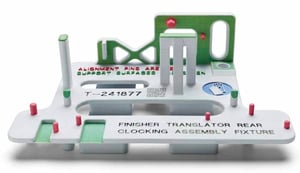Admittedly, Zprinters produced good quality color models for marketing or design concepts. They made a big impact on product development for consumer products like toys, hand tools and items where the visual appeal was just as important as functionality. The problem though, was the models were limited in their use. They couldn’t reliably be used for fit or function because they basically consisted of glued drywall powder. This made the parts fragile, heavy and brittle.
Conversely, HP’s Jet Fusion output is engineering-grade thermoplastic. The parts are actually created from fused (melted) plastic using the same process as the current production-focused HP 4200 3D printer. Currently, the color material is Nylon PA 12, which is a very durable, rigid plastic. And, parts printed on the HP Jet Fusion are extremely precise – very similar to SLS units costing over $350k.
The HP Jet Fusion 580 | 380 print in full color so they can be used for marketing or concept models. But, think bigger picture here. Think end-use parts like prosthetic devices, CMM fixtures for inspection, or labeling for unique customization per part.
Let’s look at CMM (coordinate measuring machine) fixtures as an example. The CMM measures the geometry of objects using a probe. It’s supports are traditionally manufactured using CNC machining and multiple iterations are usually created because the measured object might change during the design phase.
The CMM Fixture holding the the object needs to be precise and durable as aluminum. Typically, they will have labels and coded supports added for the inspecting engineer to know tolerances, dimensions and other important specs to make sure the inspected part being held by the CMM fixture matches the required geometry.
Just imagine the time and cost savings being able to print these fixtures in-house, in a few hours, while freeing up valuable CNC production time. And, in full color.
The new HP 300|500 series printers will start shipping in Q2 2019 and offer never seen before final use parts in the sub $100k price level AND offer color. It will be exciting to see the new markets and uses this new technology will offer.




 When HP introduced their Jet Fusion color 3D printers, some may have had initial thoughts of “ho hum, Z Corp already did this years ago.” Right?
When HP introduced their Jet Fusion color 3D printers, some may have had initial thoughts of “ho hum, Z Corp already did this years ago.” Right?